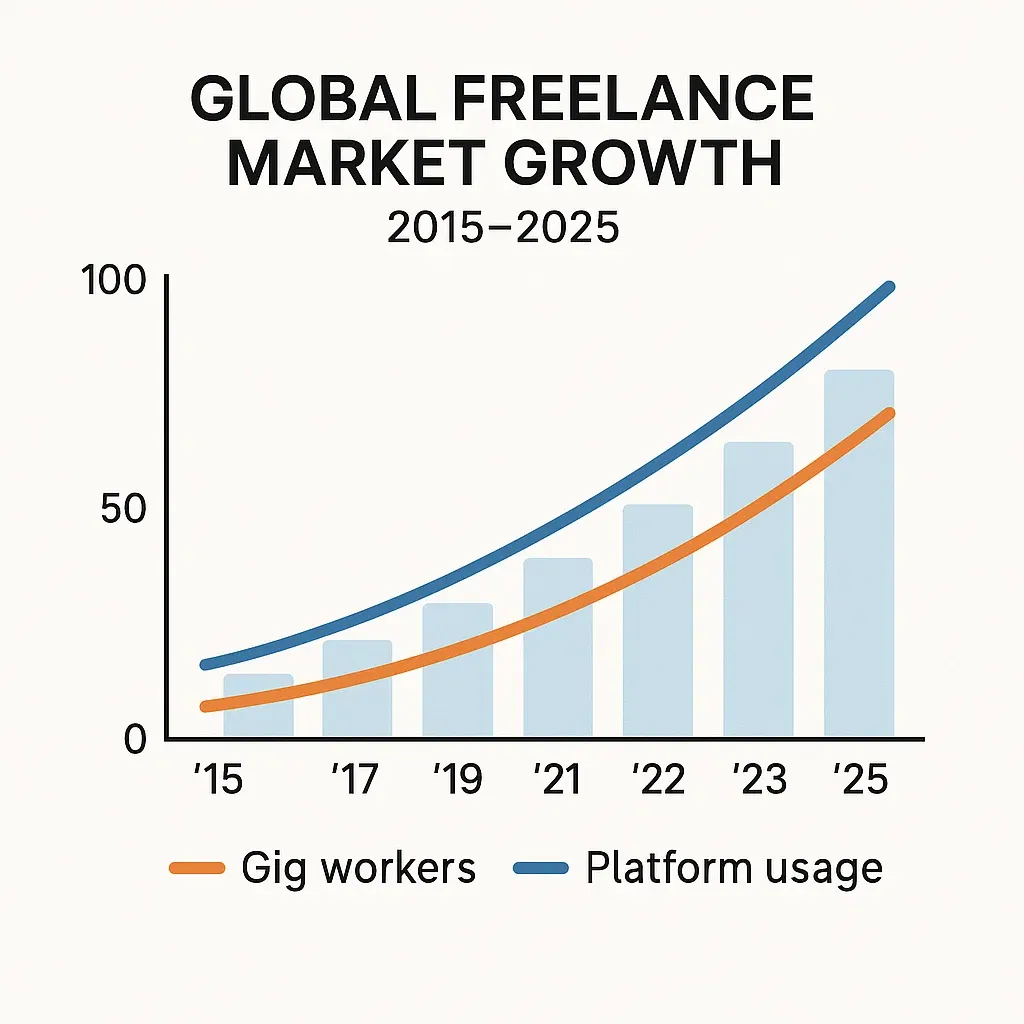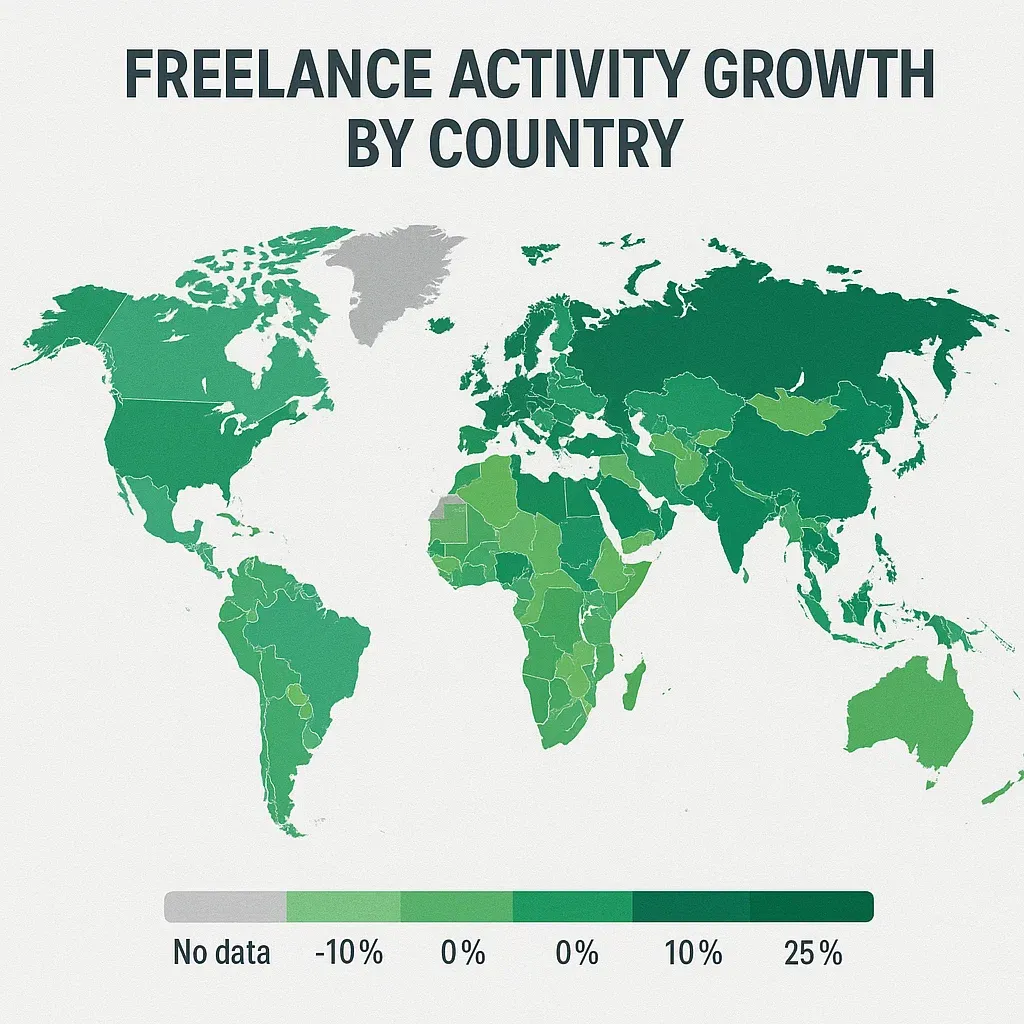Freelance platforms are no longer just side hustles — they’re the backbone of a growing global economy. As we move into 2025, freelance apps represent a compelling opportunity for startups and digital agencies eager to tap into the booming gig economy. With millions of professionals choosing flexibility over traditional employment, there’s never been a better time to build tools that connect skilled talent with the businesses that need them.
This blog will guide you through why freelance apps are one of the most profitable niches to consider in 2025, explore high-potential app ideas, and explain what makes a freelance platform successful. We’ll also break down the cost of development and show how Miracuves’ white-label clone solutions can help you go live faster and smarter.

Read more: How to Develop a Freelancer App Alternative
Why Freelance Apps Are a Hot Opportunity in 2025
The freelance economy is undergoing a seismic shift. According to Statista, over 540 million people worldwide are expected to work as freelancers by 2025 — up from 370 million in 2020. Meanwhile, CB Insights notes a steady increase in venture funding toward freelance platforms, with top players like Upwork, Toptal, and Fiverr attracting attention not just from users, but from institutional investors.
What’s driving this trend? A mix of factors:
- Remote work normalization: Post-pandemic habits have stuck. Businesses are more comfortable outsourcing globally.
- Technology enablers: Tools like Zoom, Notion, Trello, and AI-enhanced collaboration have made virtual teams more productive.
- Entrepreneurial momentum: More professionals are launching freelance careers, seeking freedom, flexibility, and higher earnings.
Despite the growth, gaps still exist — especially in niche-focused freelance platforms tailored to creatives, tech specialists, and localized service providers. This makes 2025 the perfect time to launch.

Read more: How to Start a Freelance Marketplace Platform Business
Top Profitable Freelance App Ideas to Launch in 2025
1. Creative Services Marketplace (Design, Copywriting, Video Editing)
Launch a niche platform for designers, copywriters, and video editors to connect with brands and startups. Perfect for the booming content marketing economy, it offers transaction-based revenue, premium subscriptions, and ad monetization. Creative portfolios drive trust and repeat engagement.
Monetization Strategy: Commission on transactions, subscription for premium features, ad placements.
Why It Works in 2025: Creative demand surges with content-driven digital marketing. Businesses want vetted creatives with portfolios.
2. Tech & IT Talent Network
A freelance hub tailored for software engineers, DevOps pros, and AI specialists. With tech talent shortages intensifying, this platform meets urgent hiring needs for SaaS, AI, and Web3 ventures. Monetize via per-hire fees, subscriptions, and AI-powered matching.
Monetization Strategy: Per-hire fees, enterprise subscriptions, AI skill-matching tools.
Why It Works in 2025: The AI boom, Web3 projects, and SaaS startup growth are creating massive demand for vetted engineers.
3. Local Freelance Services Platform
Build an app connecting customers with nearby service providers like makeup artists or yoga trainers. Location-based gig discovery is in high demand for real-world convenience. Revenue comes from service fees, premium listings, and in-app bookings.
Monetization Strategy: Location-based service fee, priority listing fees, in-app booking tools.
Why It Works in 2025: Consumers increasingly prefer apps that let them “book a nearby pro” instantly.
4. Freelance Legal & Financial Advisors App
Offer a platform where SMBs and startups can hire on-demand lawyers, accountants, and consultants. This app fills the need for flexible, contract-free expertise. Monetize through subscriptions, commissions, and a downloadable resource marketplace.
Monetization Strategy: Subscription, consultation commission, document/template marketplace.
Why It Works in 2025: Startups and solo founders need flexible advisory services without long-term contracts.
5. Education & eTutoring Freelance Platform
Connect tutors, coaches, and subject experts with learners through live or on-demand sessions. With lifelong learning on the rise, niche education platforms are thriving. Earn via hourly rates, subscriptions, and bundled course offerings.
Monetization Strategy: Hourly fees, monthly plans, course bundles.
Why It Works in 2025: Lifelong learning is a booming trend, and learners trust niche tutor marketplaces more than general ones.
6. Freelance Virtual Assistant Platform
Help businesses find part-time VAs for admin support, email handling, and scheduling. Remote-first teams rely on such services to stay productive. Monetization includes retainer plans, premium employer features, and task-based billing.
Monetization Strategy: Retainer plans, task-based billing, employer premium accounts.
Why It Works in 2025: Remote-first teams need help managing time-consuming tasks — and they prefer flexible, pay-as-you-go help.
7. Freelance Healthcare & Wellness Experts Platform
Create a wellness marketplace for freelance nutritionists, therapists, and fitness coaches. Health-conscious users seek accessible, on-demand care. Earn from session bookings, subscription plans, and community engagement features.
Monetization Strategy: Session booking fees, subscription wellness plans, community features.
Why It Works in 2025: Consumers are prioritizing mental and physical health, seeking on-demand professionals they can trust.
What Makes an App Profitable in the Freelance Niche?
Profitable freelance apps share several key traits:
- Recurring Revenue Streams: Subscription-based access, SaaS billing for employers, and featured listings ensure predictable income.
- High Retention Rates: Good freelancers and satisfied clients tend to stick with platforms that deliver results.
- Low Operational Overhead: Freelance apps don’t manage payroll or logistics — they act as facilitators.
- Strong User Acquisition Models: Affiliate partnerships, SEO content, and niche communities can drive steady organic traffic.
Startups often underestimate how complex it is to build from scratch. That’s why clone app development is rising fast. By leveraging ready-made white-label freelance app clones from Miracuves, founders cut costs, launch faster, and skip months of technical headaches.
Cost to Build a Freelance App in 2025
Building a freelance platform from the ground up can cost between $30,000 to $150,000+, depending on complexity.
Launch Your Freelance Platform in Just 3–6 Days — Go Live with Miracuves from $2,500 to $3,000!
Cost Factors:
- Platform: iOS, Android, or Web?
- Tech Stack: Real-time chat, AI-based matching, admin dashboards
- Backend Complexity: Payment processing, review systems, dispute handling
- UI/UX Design: Clean and responsive interfaces are critical for both client and freelancer retention
But smart founders are cutting through the noise with Miracuves’ white-label freelance app solutions, offering scalable codebases that are customizable, affordable, and launch-ready.
Tips for Founders to Launch a Successful Freelance App
1. Start with an MVP
Don’t try to be everything at once. Launch with a core service and expand based on feedback.
2. Invest in Stellar UI/UX
First impressions matter. Intuitive design builds trust with both clients and freelancers.
3. Validate Before You Build
Run surveys, landing pages, or beta programs to validate the demand before heavy development.
4. Build Scalable Architecture
Don’t let your backend break when traffic spikes. Choose cloud-native infrastructure from day one.
5. Market Aggressively Post-Launch
From influencer campaigns to SEO content marketing, user acquisition needs equal priority as development.
Read more: Top 10 Ideas for Freelance and Gig Economy Business Startups in 2025
Conclusion
The freelance economy is flourishing — and it’s only getting stronger. With remote work here to stay, businesses are increasingly reliant on agile, talent-matching platforms. Launching a freelance app in 2025 isn’t just smart — it’s potentially game-changing.
And with clone app development solutions from Miracuves, you can skip the technical delays and focus on growing your business. From legal freelance networks to creative service hubs, there’s room for innovation and profitability — if you act fast.
At Miracuves, we help innovators launch high-performance app clones that are fast, scalable, and monetization-ready. Ready to turn your idea into reality? Let’s build together.
FAQs
Q:1 How much does it cost to build a freelance app?
The cost to build a freelance app typically ranges from $2,500 to $3,000 with Miracuves’ rapid 3–6 day Go-Live package.
Q:2 What features should a successful freelance app include?
User profiles, job matching, secure payments, ratings, and real-time messaging.
Q:3 Is it better to build from scratch or use a clone solution?
Clone solutions offer faster time-to-market and lower costs, ideal for most startups.
Q:4 Can I customize a Miracuves clone solution for my niche?
Yes. All Miracuves clones are fully white-label and customizable to fit your target market.
Q:5 How long does it take to launch using a clone?
You can go live in 2–6 weeks depending on customization needs — far faster than scratch-built apps.
Q:6 Will my clone app be scalable?
Absolutely. Miracuves solutions are built to scale with cloud-native technologies and modular components.
Related Articles:
- How to Build an App Like Fiverr: Full Developer Guide for JS & PHP Stacks
- How to Build an App Like Upwork (Full-Stack Developer’s Guide for JavaScript & PHP Stacks)
- Freelancer App Marketing Strategy: How to Get Your Platform Noticed, Used & Loved
- Upwork vs Fiverr: Business Model Comparison for Startups








